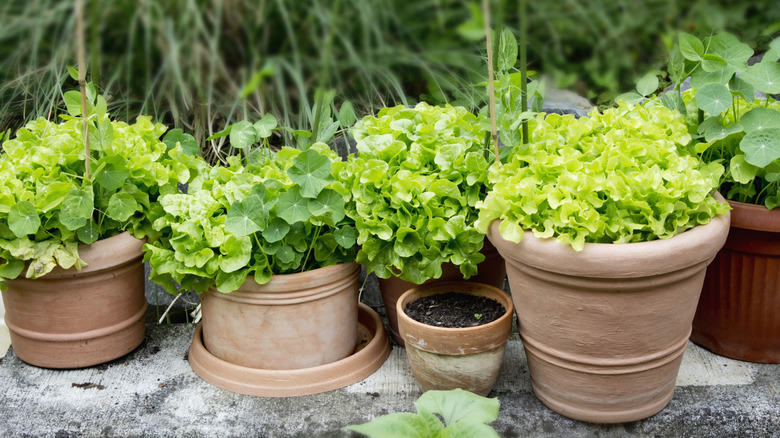A Simple Paper Plate Is The Secret To Harvesting Your Leafy Green Vegetables Better
We may receive a commission on purchases made from links.
Leafy or salad greens regularly top lists of easy-to-grow vegetables for a container garden. Whether you're talking lettuce, arugula, spinach, or Swiss chard, they all grow easily from seed, need few inputs, and mature to harvest fast. Before you jump into your car and head to the plant nursery for planters, potting mix, and packets of seeds, you need to consider how you'll tackle one often overlooked problem container vegetable gardeners face: soil splashing onto their crops when watering. Not only does this mean you have to wash your harvested vegetables more thoroughly before chowing down on them, but you also risk introducing pathogens that compromise the health of your plants before they even reach the kitchen. Thankfully, there's an easy solution. Cut a hole in the middle of a paper plate, fit it over the soil of your planter, and plant your vegetable seed or seedling into the hole.
Why does this simple trick work? Mulching enhances the benefits of growing a container garden, and the paper plant effectively acts as mulch. Mulch creates a barrier between your soil and your plant that serves various purposes. It stops soil splashing onto the leaves when you water or when it rains, keeping them clean and reducing the spread of disease. It also stops weeds germinating in your planters and out-competing your vegetables for limited nutrients. Paper products like shredded or layered newspaper and cardboard are popular mulch materials, so it's not a stretch to extend this to paper dinnerware. Aim to cover at least a foot of the soil around your plant with mulch — something that's easy to achieve in planters on the smaller side.
How to fit a paper plate into your leafy greens garden planter
If you're lucky, you might be able to score free mulch for your container-grown leafy greens; ask family, friends, or neighbors if they have a stash of paper plates they don't use. If you decide to (or have to) buy your paper plates, look for biodegradable options. While the plate likely won't stay in your pot for too long — you can harvest most leafy green vegetables within 70 days from sowing — you also won't have to worry about harmful substances like per- and polyfluoroalkyl substances (PFAS) leaching into your soil.
For small-sized pots, a 20-pack of 6-inch World Centric Wheat Straw Compostable Fiber Plates costs about $7. Or pay a bit over $3 for a pack of 16 Hefty ECOSAVE 10 and 1/8 inch Compostable Compartment Paper Plates for large containers. If you have rectangular or square pots, a pack of 7 and 10-inch square Raj Compostable and Biodegradable Disposable Bamboo Plates costs about $27.
Measure the diameter of your planter and find out how large whatever leafy greens you've planted will get at harvest time, diameter-wise. For example, extra dwarf pak choi maxes out at 3 inches in diameter, whereas Romaine (also called cos) lettuce can reach 1 foot in diameter. Once you know both of these measurements, buy a paper plate that will fill the planter, then cut a hole in the center of it to accommodate the future growth of your vegetables of choice. Sow your seeds or plant your seedlings in the center of the hole, and care for your leafy greens as usual.
